The battle over Gaza’s future: Why no one can agree on the rebuild
18 minutes ago
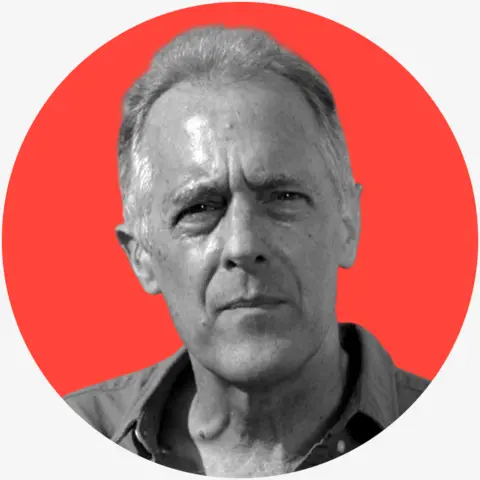 Paul AdamsDiplomatic correspondent
Paul AdamsDiplomatic correspondent

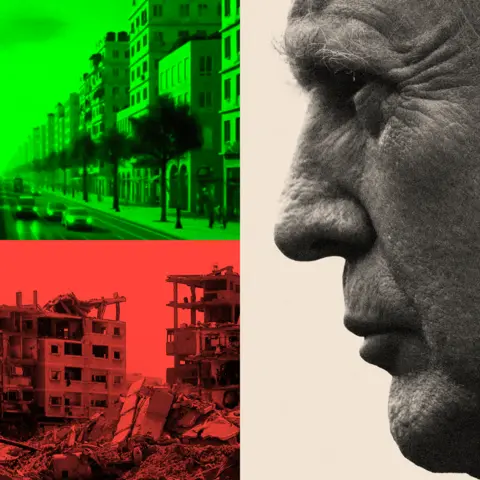 BBC
BBCIn the midst of a still shaky ceasefire, Gazans are taking the first tentative steps along the long road to recovery.
Bulldozers are clearing roads, shovelling the detritus of war into waiting trucks. Mountains of rubble and twisted metal are on either side, the remains of once bustling neighbourhoods.
Parts of Gaza City are disfigured beyond recognition.
“This was my house,” says Abu Iyad Hamdouna. He points to a mangled heap of concrete and steel in Sheikh Radwan, which was once one of Gaza City’s most densely populated neighbourhoods.
“It was here. But there’s no house left.”

 AFP via Getty Images
AFP via Getty ImagesAbu Iyad is 63. If Gaza ever rises from the ashes, he doesn’t expect to be around to see it.
“At this rate, I think it’ll take 10 years.” He looks exhausted and resigned. “We’ll be dead… we’ll die without seeing reconstruction.”
Nearby, 43-year-old Nihad al-Madhoun and his nephew Said are picking through the wreckage of what was once a home.
The building might well collapse but it doesn’t deter them – they collect old breeze blocks and brush thick dust off an old red sofa.
“The removal of rubble alone might take more than five years,” he says. “And we will wait. We have no other option.”
The sheer scale of the challenge is staggering. The UN estimates the cost of damage at £53bn ($70bn). Almost 300,000 houses and apartments have been damaged or destroyed, according to the UN’s satellite centre Unosat.
The Gaza Strip is littered with 60 million tonnes of rubble, mixed in with dangerous unexploded bombs and dead bodies.


In all, more than 68,000 people have been killed in Gaza in the past two years, according to the territory’s Hamas-run health ministry. Its figures are accepted by the United Nations and other international bodies.
In the midst of such destruction, it’s hard to know where to begin.
There’s no shortage of ideas – including grand designs conceived by those with money and power in faraway capitals. The US President Donald Trump had his say too.
But Gazans we spoke to are sceptical of schemes drawn up abroad, and they have visions of their own. So the fight is on to shape Gaza’s future.
The question is, who will prevail?
From Trump’s riviera to the Phoenix plan
Yahya al-Sarraj, Gaza City’s Hamas-appointed mayor, is out on the streets wearing a hi-vis jacket and surveying the ruins. Already, shops and restaurants are starting to reopen, he points out.
“Of course it’s very modest,” he says, “but they want to live, and they deserve to live.”
Gaza is no stranger to these destructions, he adds, recalling several conflicts prior to the cataclysm that erupted, following the devastating attack that Hamas launched on Israel on 7 October 2023.
“We heard about a lot of plans, international, local, regional plans. [But] we have our own plan.
“We call it the Phoenix of Gaza.”
This was the first home-grown Palestinian plan to emerge during the war – in a computer-generated video that accompanied it, shattered communities are seen transformed, as if by magic, into modern neighbourhoods.
“We wanted to fill the vacuum,” says Yara Salem, an infrastructure specialist, formerly of the World Bank, with experience in conflict areas including post-war Iraq.
“You cannot have foreign-imposed reconstruction plans while you don’t have any vision about your own country.”
The publication of the Phoenix plan in February followed 13 months of work by a broad coalition of around 700 Palestinian reconstruction experts, some based abroad. It drew on the knowledge and experience of architects and engineers across the Gaza Strip too. Students at Birzeit University in the occupied West Bank were also involved as the idea evolved.
Hamas, which exercises political control over the municipalities, was not involved.
Today, the creators of the Phoenix plan know that its fate is out of their hands, as competing interests, in the Middle East and beyond, jostle for control of Gaza’s future.
This vision stands in sharp contrast to the glitzy “Gaza Riviera”, a controversial proposal first described in February by President Trump during a meeting with Israel’s Prime Minister Benjamin Netanyahu at the White House.

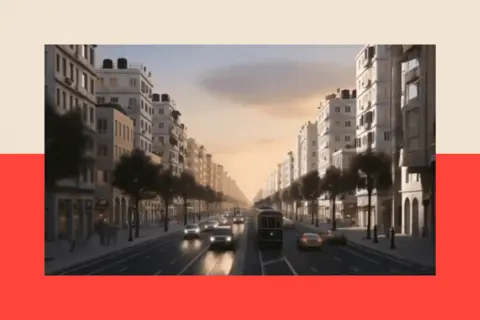 Phoenix
PhoenixTrump famously reposted a bizarre AI-generated video on his social media account, showing himself, Netanyahu and billionaire entrepreneur Elon Musk enjoying the high life in a kind of Dubai-style fantasy.
A giant golden statue of the president towered over a street and bearded male belly dancers wearing green headbands were pictured on the beach.
Though the video was clearly a spoof, President Trump had already spoken of the US taking “a long-term ownership position” in Gaza.

 Getty Images
Getty Images“Gaza’s waterfront property could be very valuable,” his son-in-law Jared Kushner told an audience at Harvard University last year, “if people would focus on building up livelihoods.”
Trump’s 20-point Gaza ceasefire proposal, agreed in October, also includes references to a “Trump economic development plan to rebuild and energise Gaza”, alongside an international “Board of Peace” to oversee governance – there has been speculation about whether former UK Prime Minister Tony Blair could end up at its helm.
High-tech, AI-powered ‘smart cities’
But Trump’s “Gaza Riviera” is not the only glossy vision of a futuristic Gaza that has emerged.
A leaked document, published in August by The Washington Post, painted a similar vision of a high-tech Gaza Strip, under US trusteeship for 10 years.
Dubbed the Gaza Reconstitution, Economic Acceleration and Transformation Trust – “Great” for short – the plan was said to be the work of Israeli and American consultants, with input from members of Tony Blair’s Institute for Global Change.
The plan envisaged the creation of a series of “modern and AI-powered smart planned cities”, noting that poor urban design lay at the heart of “Gaza’s ongoing insurgency.”

 Great
Great
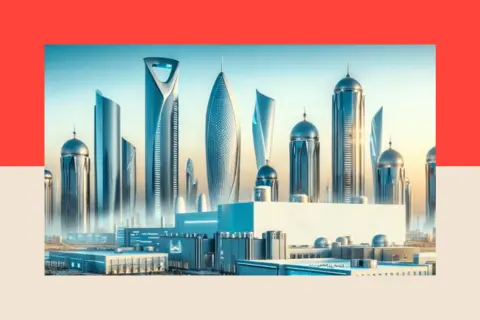 Great
Great“From a Demolished Iranian Proxy to a Prosperous Abrahamic Ally,” the plan’s subtitle read, in a nod to the Abraham Accords brokered during Trump’s first presidential term, suggesting that a revived Gaza could form part of a much larger regional peace initiative.
The plan also nodded to the idea of “voluntary relocation,” under which a quarter of Gaza’s population would leave the Strip, in return for a $5,000 (£3,780) relocation package and subsidised rent abroad.
It all stands in sharp contrast to the Phoenix plan that sets out to protect Gaza’s existing infrastructure and, where possible, restore the area’s social and geographical fabric.
“These sort of almost hallucinatory plans are creating an opening for disaster capitalism that is worrying,” argues Raja Khalidi, director general of the Palestine Economic Policy Research Institute, an independent think tank.
“The state has the ability to plan… what sort of Gaza we want to build, and when we want to build it and how much it’s going to cost us.
“It has to be a Palestinian vision – my concern [is that] we will be sidelined.”

 Reuters
ReutersShelly Culbertson, a senior researcher at the US-based RAND non-partisan think tank and co-author of a detailed study on Gaza reconstruction, also believes that the Gaza Strip is not simply a blank slate waiting to be turned into a new version of Dubai.
“There’s a lot of heritage, cities that have been around for… millennia,” she says. “It’s not good practice to just wipe it all out and start over, but rather build with what you have.”
‘The soul and spirit of Gaza’
These are not the only plans however. Another, drafted by Egypt and adopted hastily by the Arab League at a summit in Cairo in March, spoke of rebuilding Gaza over a period of five years – like the Phoenix plan, it emphasised the importance of involving Gazans in every stage “to foster a sense of ownership and ensure that the needs of the local community are met”.
Meanwhile the Palestinian Authority (PA), led by President Mahmoud Abbas, has been developing its own proposals for the Gaza Strip, as part of a wider plan to reconnect Gaza and the occupied West Bank in a future Palestinian state.
At his office in Ramallah, Estephan Salameh, the PA planning minister told me that whatever plan is settled upon, Gaza of the future would look different, but that some things would have to stay the same.

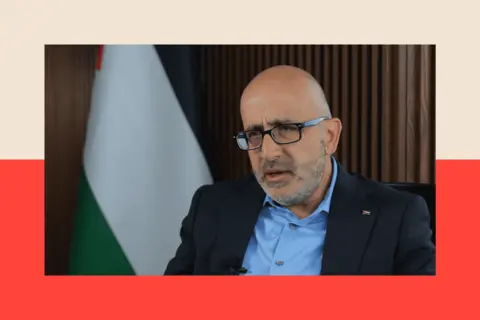
“Don’t forget that 70% of Gaza’s population are Palestinian refugees,” he says. “And we need to preserve the refugee identity. We need to preserve the soul and the spirit of Gaza.”
For Salameh, that means recreating Gaza’s pre-war refugee camps, where hundreds of thousands of descendants of Palestinians, who fled or were driven from their homes in the war surrounding Israel’s creation in 1948-9, have lived ever since.
Over time, the camps have evolved, from the canvas tents and tin shacks of the 1950s into busy, overcrowded communities with some of the highest population densities in the world.
The PA plan is not to recreate slums, but to make sure that tight-knit communities can be restored.

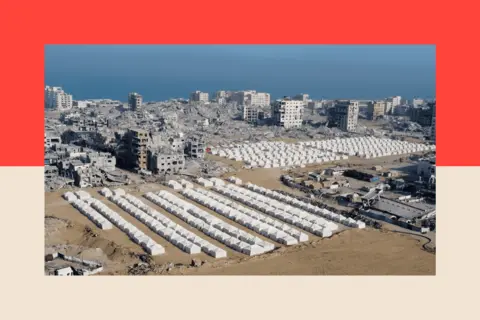 Reuters
Reuters“We want to have Jabalia rebuilt where it was,” Salameh says, referring to the biggest camp that was once home to more than 100,000 people, and that is now largely destroyed.
But for the time being, the Palestine Authority’s rule only extends to the West Bank, not Gaza. Trump’s Gaza ceasefire plan says the Board of Peace will handle Gaza’s redevelopment “until such time as the Palestinian Authority has completed its reform programme”.
A slow, painstaking process
Reconstruction is likely to be a slow, painstaking process, one that Shelly Culbertson calls “incremental urbanism”.
“Living in the damaged but habitable communities and rebuilding while in them, we think is going to be a key way of preserving communities and allowing people to move back,” she says.
“[But] some places have been so destroyed and damaged and dangerous that the only thing to do really is wall them off, raise them down and completely rebuild.
“This is not going to be a five-year recovery – it’s probably going to take decades.”

 Anadolu via Getty Images
Anadolu via Getty ImagesThe Palestinian Authority’s planning minister predicts a quicker timeline but says nothing can begin until political and security arrangements are in place, borders are open (to allow the import of building materials) and funding is secured.
But therein lies the rub. In order for international donors to pledge the tens of billions of dollars needed to rebuild Gaza, there has to be agreement on what a recovery plan will look like.
Egypt plans to hold a reconstruction summit but a date has not yet been set. And the most likely funders – Saudi Arabia and the UAE – will need reassurances that their colossal investments are not simply going to go up in smoke in some future Gaza war.
But with the current Israeli government strongly opposing the creation of a Palestinian state – something that Saudi Arabia is also pushing for – the political obstacles are formidable.

 Reuters
ReutersIsrael has previously said that it is not opposed to investors and builders from a variety of countries beginning efforts to rebuild in areas controlled by the IDF.
On a recent visit to Israel, Jared Kushner spoke of building “a new Gaza” on territory still under Israeli military control, saying no reconstruction funds would go to areas controlled by Hamas.
But nothing substantial can happen while the Gaza ceasefire hangs by a thread, and Israel and Hamas still trade occasional blows.
Back in the shattered remains of Gaza City’s Sheikh Radwan neighbourhood, Abu Iyad Hamdouna has more immediate concerns.
“Reconstruction?” he exclaims. “What about water?”
After five forced displacements during the war, Abu Iyad just wants to stay put, in whatever shelter he can find, or make for himself.
He’s not waiting for the Phoenix to rise or indeed for any sort of Gaza Riviera to materialise.
“Here we are, making tents,” he says. “We are sitting making tents, next to the house we still cannot live in.”
Lead image credit: Bloomberg/Reuters/ Phoenix. Image shows destroyed buildings in Gaza (bottom left) and an AI-generated impression of the Phoenix plan (top left)


BBC InDepth is the home on the website and app for the best analysis, with fresh perspectives that challenge assumptions and deep reporting on the biggest issues of the day. You can now sign up for notifications that will alert you whenever an InDepth story is published – click here to find out how.
More from InDepth